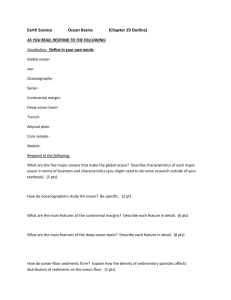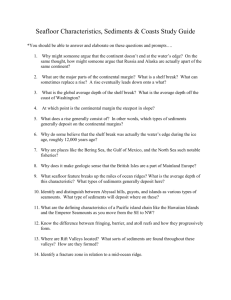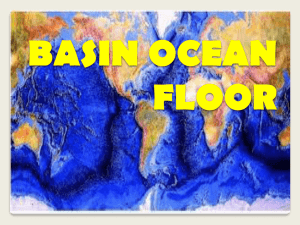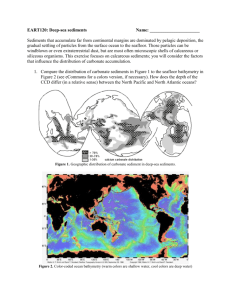Section 3 – Ocean
advertisement
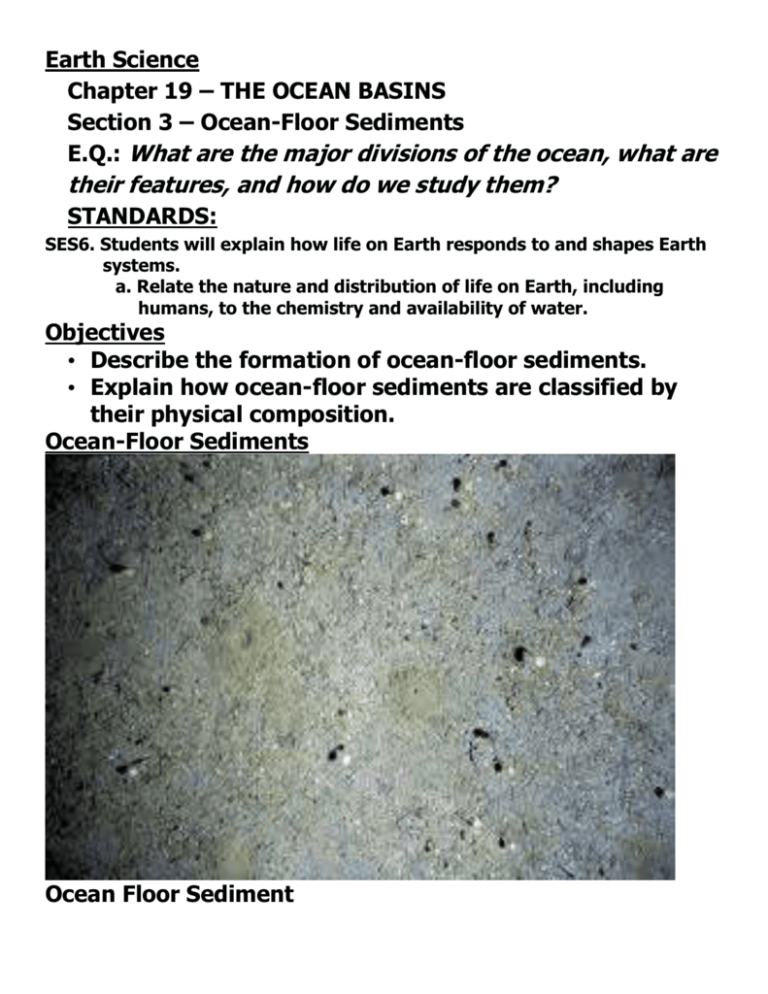
Earth Science Chapter 19 – THE OCEAN BASINS Section 3 – Ocean-Floor Sediments E.Q.: What are the major divisions of the ocean, what are their features, and how do we study them? STANDARDS: SES6. Students will explain how life on Earth responds to and shapes Earth systems. a. Relate the nature and distribution of life on Earth, including humans, to the chemistry and availability of water. Objectives • Describe the formation of ocean-floor sediments. • Explain how ocean-floor sediments are classified by their physical composition. Ocean-Floor Sediments Ocean Floor Sediment • The composition of ocean sediments varies and depends on which part of the ocean floor the sediments form in. • Coarse gravel and sand are usually found close to shore because these heavier sediments do not move easily offshore. South Carolina Coastal Estuary Buildup Shoreline seawall near Anacortes, WA. • Lighter particles are suspended in ocean water and are usually deposited at a great distance from shore. Sources of Deep Ocean-Basin Sediments core sample - a cylindrical piece of sediment, rock, soil, snow, or ice that is collected by drilling • The study of sediment samples show that most of the sediments in the deep-ocean basins are made of materials that settle slowly from the ocean water above. • These materials may come from organic or inorganic sources. Using a custom designed "push-core" sampler, ROPOS uses one of its manipulator arms to collects 12,000+ year old clay for geological analysis. Teams of scientists study seafloor core samples in sequence to reconstruct events and phenomena over millions of years of Earth history. (Ocean Drilling Program.) All cores recovered through scientific ocean drilling under the auspices of the Deep Sea Drilling Project (1968-1983) and the Ocean Drilling Program (1983-2003) have been moved to the Gulf Coast Repository (GCR) in College Station, TX, the Bremen Core Repository (BCR) in Germany or the Kochi Core Center (KCC) in Japan. These three permanent archive locations are also the home to all cores taken by the Integrated Ocean Drilling Program (2003-present). Inorganic Sediments • Some ocean-basin sediments are rock particles that were carried from land by rivers. • Other deep ocean-basin sediments consist of fine particles of rock, including volcanic dust, that have been blown great distances out to sea by the wind. • Icebergs also provide sediments that can end up on the ocean basins. Even meteorites contribute to deep ocean-basin sediments. Biogenic Sediments • The word biogenic comes from the Latin words bios, which means “life,” and genus, which means “origin.” • Biogenic sediments are the remains of marine plants and animals. The two most common compounds found in organic sediments are silica, SiO2, and calcium carbonate, CaCO3. Organic and inorganic sediment These electron microscope images show fine marine sediments made up of mineral and plant particles. The top image shows quartz grains composed of the mineral silica. Because quartz is very resistant to chemical weathering, it is common in beach and ocean sands. The lower image shows sediment made of the remains of diatoms – a common plant plankton also composed of silica. In general, inorganic sediments are more common close to land, and organic sediments more common offshore. Chemical Deposits nodule - a lump of minerals that is made of oxides of manganese, iron, copper, or nickel and that is found in scattered groups on the ocean floor • When chemical reactions take place in the ocean, solid materials can form. • When substances that are dissolved in ocean water crystallize, these materials settle to the ocean floor as potato-shaped lumps of minerals called nodules. Manganese nodules on the seabed of Pacific Ocean READING CHECK How do nodules form? When chemical reactions take place in the ocean, dissolved substances can crystallize to form nodules that settle to the ocean floor. Physical Classification of Sediments • Based on physical characteristics, deep ocean-floor sediments are classified as mud or as ooze. • Muds are very fine silt- and clay-sized particles of rock. Ocean Mud What’s the News: Researchers have found high concentrations of rare earth metals, essential materials for making nearly all hightech electronics, in mud on the floor of the Pacific Ocean, according to study published online earlier this week in Nature Geoscience. These huge deposits could help satisfy ever-increasing demand for rare earth metals, but there are major questions about the economic viability and ecological effects of mining the seabed. • Calcareous ooze is ooze that is made mostly of calcium carbonate. Calcareous ooze • Siliceous ooze, which can be found at any depth, is made of mostly silicon dioxide, which comes from the shells of radiolarians and diatoms. Diatoms in Siliceous ooze Various organisms found in Siliceous ooze
